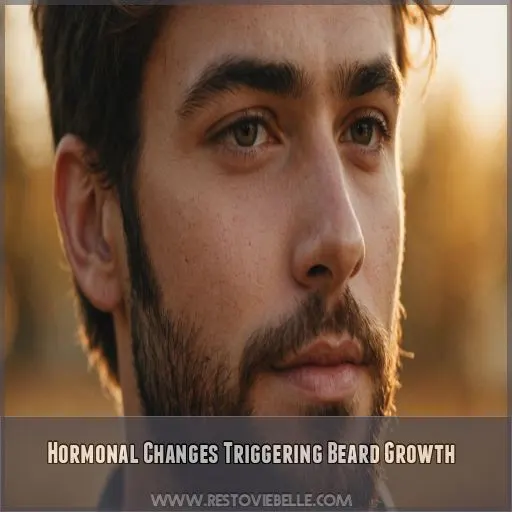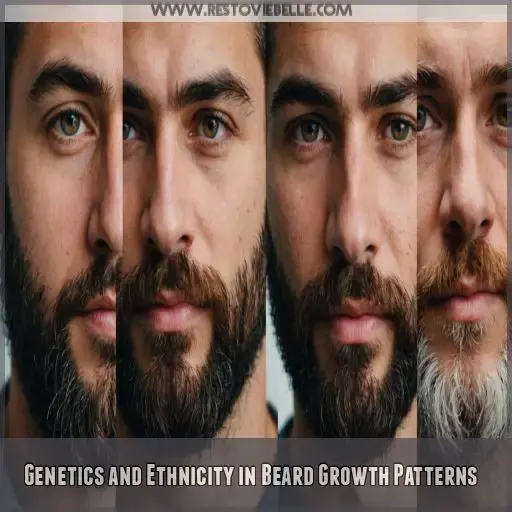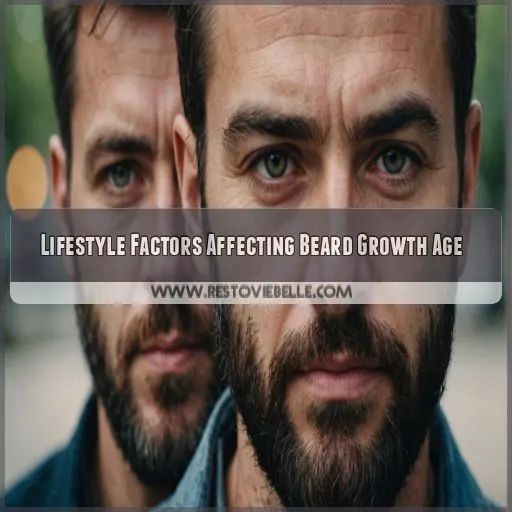This site is supported by our readers. We may earn a commission, at no cost to you, if you purchase through links.
 The age-old question (pun intended!): how old are you when you start to grow a beard?
The age-old question (pun intended!): how old are you when you start to grow a beard?
You’re likely to notice those first pesky hairs on your face around 15 or 16.
But don’t worry if you’re a late bloomer – genetics play a huge role, so if your dad’s got a luscious beard, you might too!
On average, boys start growing their first real beard between 17 and 21.
Factors like hormones, nutrition, and lifestyle can influence your beard’s development.
Table Of Contents
- Key Takeaways
- Beard Growth Timeline: When Does It Start?
- Hormonal Changes Triggering Beard Growth
- Stages of Beard Development by Age
- Genetics and Ethnicity in Beard Growth Patterns
- Beard Growth Rate and Fullness Over Time
- Lifestyle Factors Affecting Beard Growth Age
- Medical Conditions Impacting Beard Growth Age
- Frequently Asked Questions (FAQs)
- At what age will I get a full beard?
- Is it OK to have beard at 12?
- Will I grow a beard after 18?
- What does a 6 month beard look like?
- Can beard growth be stimulated with certain vitamins and supplements?
- How often should I wash my beard to promote healthy growth?
- Can certain hairstyles or facial features affect beard growth appearance?
- Are there any common mistakes to avoid when growing a beard?
- Can beard growth be affected by environmental factors like climate?
- Conclusion
Key Takeaways
- You’ll likely start noticing those first pesky hairs on your face around 15 or 16, but don’t worry if you’re a late bloomer – genetics play a huge role, so if your dad has a luscious beard, you might too!
- Your beard growth journey is influenced by various factors, including genetics, hormones, nutrition, lifestyle, and ethnicity, so be patient and don’t stress if your beard is fashionably late to the growth game.
- The typical age range for your first real beard is between 17 and 21, but some guys won’t see significant growth until their mid-20s – it’s like watching grass grow, but on your face!
- By understanding the interplay of genetics, hormones, and lifestyle factors, you can nurture your facial hair journey and grow a majestic mane that’s uniquely yours – just remember, good things come to those who wait!
Beard Growth Timeline: When Does It Start?
Curious about when your beard might start sprouting? You’re not alone – the timing of beard growth is a common question for many young men, and the answer isn’t always straightforward.
Puberty and Initial Facial Hair Growth
As puberty kicks off, your body’s hormonal orchestra begins its beard-growing symphony. While everyone’s timeline differs, here’s what you might experience:
- Peach fuzz appears
- Voice deepens
- Adam’s apple becomes prominent
- Body odor intensifies
- Chest hair emerges
Buckle up for a wild ride through adolescence!
Typical Age Range for First Beard Growth
While puberty kicks off facial hair growth, the typical age range for your first real beard is 17 to 21. Don’t fret if you’re a late bloomer – some guys won’t see significant growth until their mid-20s. Your beard journey’s just beginning!
Factors Influencing Early Beard Development
Ever wondered why some guys sprout beards earlier than others? Your early beard growth is influenced by various factors:
- Genetics: Your DNA blueprint
- Hormones: Testosterone and DHT levels
- Nutrition: Fuel for follicles
- Lifestyle: Exercise and stress management
- Ethnicity: Cultural beard patterns
Understanding these can help you nurture your facial hair journey.
Variations in Beard Growth Onset
While genetics and ethnicity play a big role, your beard growth journey’s as unique as you are. Some guys might sprout stubble in their teens, while others won’t see a full beard until their late twenties. It’s all part of your personal facial hair adventure!
Hormonal Changes Triggering Beard Growth
Now that we’ve covered when beard growth starts, let’s talk about the hormonal orchestra behind your facial fuzz. Your body’s conducting a symphony of hormones, with testosterone taking center stage. This powerhouse hormone transforms into DHT, the real star of the show when it comes to beard growth.
During puberty, your hormones kick into high gear, triggering:
- Increased testosterone production
- Higher DHT levels
- Activation of facial hair follicles
- Changes in hair texture and thickness
It’s like your face is throwing a hair-raising party, and these hormones are the VIP guests. Remember, everyone’s hormonal timeline is unique, so don’t sweat it if your beard’s fashionably late to the growth game.
Stages of Beard Development by Age
Wondering when you’ll start sprouting that manly beard? Let’s explore the stages of beard development by age, from those first wisps of peach fuzz to a full-grown face mane.
Teenage Years (13-19)
During your teenage years, you’ll likely start noticing facial hair sprouting. It’s a bit like planting a garden – some patches grow faster than others. Don’t fret if your beard’s patchy; it’s normal. Embrace the journey and experiment with different grooming techniques.
Early Twenties (20-24)
As you enter your early twenties, your beard growth journey kicks into high gear. You’ll likely notice patchy growth and uneven development. It’s time to experiment with different styles and establish grooming habits. Embrace this phase – it’s your beard’s awkward teenage years!
Mid to Late Twenties (25-29)
Hitting your stride in your mid to late twenties? Your beard’s likely reaching its peak growth period. You’ll notice increased thickness and styling options. It’s time to establish a solid grooming routine and consider how your facial hair might impact your career. Embrace the power of your evolving look!
Thirties and Beyond (30+)
As you hit your thirties, your beard’s journey takes a new turn. Growth slows down, and those pesky gray hairs might crash the party. Your once-soft whiskers may become coarser, demanding more TLC. But hey, with age comes wisdom – and a distinguished beard!
Genetics and Ethnicity in Beard Growth Patterns
You might wonder why your best friend sprouted a full beard at 16 while you’re still waiting for yours to fill in at 25. The answer lies in the fascinating interplay of genetics and ethnicity, which can substantially influence when and how your facial hair develops.
Genetic Factors Influencing Beard Growth
Your beard’s destiny is written in your DNA. Genetic factors play a starring role in your facial hair journey, influencing everything from follicle density to androgen sensitivity. Like a family heirloom, hereditary patterns pass down beard growth traits. But remember, your genes aren’t a life sentence – they’re just one chapter in your unique beard story.
Ethnic Variations in Beard Development
Beyond genetics, your ethnic background plays a fascinating role in beard growth. You’ll find striking variations across different cultures:
- Mediterranean men often sport thick, full beards
- East Asian men typically have lighter facial hair
- African men tend to have coarser, curlier beard textures
These differences stem from genetic diversity and hormonal variations unique to each ethnicity. Embracing your natural growth pattern can be empowering and help you rock your individual style.
Family History and Beard Growth Predictions
Discover the mystery of your future beard? Find answers in your family tree! Your genetic blueprint contains clues about when and how your facial hair will sprout. Examine this handy guide to predict your beard’s destiny:
| Family Member | Beard Type | Your Likelihood |
|---|---|---|
| Father | Full | High |
| Grandfather | Patchy | Moderate |
| Uncle | Goatee | Low |
| Brother | Thick | Very High |
Beard Growth Rate and Fullness Over Time
Ever wondered how fast your beard actually grows? You’re about to discover the truth about beard growth rates, You’re about to discover the truth about hair growth rates, how long it takes to grow hair to mid back length, and why some individuals end up with varying hair growth rates while others sprout healthy, even hair.
, and why some guys end up with patchy facial hair while others sprout lush, even beards.
Daily and Monthly Beard Growth Rates
While genetics play a role, let’s talk numbers. Your beard grows between 0.3 and 0.5 millimeters daily. That’s about one-third to one-half inch per month. It’s like watching grass grow, but on your face!
- Growth measurement can vary seasonally
- Nutrition impacts beard growth rate
- Grooming effects can influence perceived growth
- Genetic differences lead to varied growth rates
Time Frame for Full Beard Development
Now that you know how fast your beard grows, let’s talk about the full picture. Growing a complete beard isn’t a sprint—it’s a marathon. Most guys need 2-4 months to achieve their ultimate facial fur. Check out this breakdown of what you can expect:
| Month | Growth Stage | Appearance |
|---|---|---|
| 1 | Stubble | Scruffy |
| 2 | Short Beard | Defined |
| 3-4 | Full Beard | Glorious |
Patchy Growth and Uneven Beard Development
Why do some beards grow in patchy or uneven? It’s a common frustration, but don’t worry – you’re not alone. Here are some reasons and solutions for patchy beard growth.
- Genetics play a significant role
- Hormonal imbalances can cause uneven growth
- Age affects beard fullness
- Nutrition impacts hair growth
- Stress can hinder beard development
Lifestyle Factors Affecting Beard Growth Age
While genetics play a significant role in beard growth, your lifestyle choices can also impact when and how well your facial hair develops. From what you eat to how much you sleep, these factors can influence your beard’s growth timeline and fullness.
Nutrition and Dietary Impact on Beard Growth
Your beard’s growth isn’t just about time – it’s also what’s on your plate. Fuel your facial hair with protein-packed meals and vitamin-rich foods. Don’t forget to stay hydrated and load up on omega-3s. Your beard will thank you for the nutritional boost!
Exercise and Physical Activity Effects
- Increases testosterone levels
- Improves blood circulation
- Enhances overall health
- Promotes muscle growth
Stress and Sleep Influence on Beard Development
Under the weight of stress, your beard growth might slow to a crawl. Your body’s circadian rhythm plays a vital role too. By prioritizing quality sleep and mastering relaxation techniques, you’re not just growing a beardyou’re cultivating a stress-free lifestyle that’ll make your whiskers flourish.
Environmental Factors and Beard Growth
Ever wonder how your environment shapes your beard? Climate, pollution, and sun exposure can all impact growth. High altitudes might slow it down, while humidity can make it unruly. Don’t let these factors discourage you – understanding them puts you in control of your facial hair journey.
Medical Conditions Impacting Beard Growth Age
While genetics and age play significant roles in beard growth, certain medical conditions can throw a wrench in your facial hair plans. From hormonal imbalances to skin issues and medication side effects, various health factors might affect when (and how) your beard decides to make its grand entrance.
Hormonal Imbalances and Beard Development
Here’s the thing: hormonal imbalances can considerably impact beard growth. Conditions like testosterone deficiency, thyroid disorders, adrenal imbalances, prolactin excess, and androgen insensitivity can all hinder your beard’s progress. If you’re concerned, you should consult a doctor to rule out any underlying hormonal issues and get your beard back on track.
Skin Conditions Affecting Facial Hair Growth
Skin conditions can hamper beard growth. Don’t let folliculitis, ingrown hairs, or dermatitis get in the way of your beard goals. Here are three skin conditions to watch out for:
- Folliculitis: inflamed hair follicles that can lead to beard loss.
- Ingrown hairs: red, itchy bumps that can cause scarring.
- Seborrheic dermatitis: flaky skin that can slow beard growth.
Medications Influencing Beard Growth Onset
You might be surprised to learn that certain medications can impact your beard growth. Some meds, like those for depression, high blood pressure, and cancer, Some meds, like those for depression, high blood pressure, and cancer, can cause hair loss causes or slow down growth as a side effect.
. These medications may alter testosterone levels, leading to changes in your beard’s thickness and fullness.
Frequently Asked Questions (FAQs)
At what age will I get a full beard?
Give it time, good things come to those who wait" – your beard will thank you! Typically, most men see significant beard thickening around age 25, with a full beard developing between 17 and 30 years old.
Is it OK to have beard at 12?
Hey, Hey, it’s not uncommon for some guys to start growing facial hair as early as 12, but a full beard is unlikely at this age, since beard growth is influenced by genetics, hormones, and lifestyle factors.
, but a full beard is unlikely at this age. Hormonal changes during puberty can trigger early growth, but it’s usually patchy and uneven.
Will I grow a beard after 18?
Growing a beard is like cultivating a garden – it takes time and patience. After 18, your testosterone levels will likely increase, and your beard will start to fill out, but it may take a few years to reach its full potential.
What does a 6 month beard look like?
At 6 months, your beard will likely be full and bushy, with a defined shape. It may reach 3-4 inches in length, with some areas thicker than others, so be patient and enjoy the journey!
Can beard growth be stimulated with certain vitamins and supplements?
Ready to grow a fuller beard? While there’s no magic pill, certain vitamins like biotin, vitamin D, and B-complex can stimulate beard growth. Just remember, patience is key, as growth rates vary from person to person.
How often should I wash my beard to promote healthy growth?
Washing your beard 2-3 times a week is a sweet spot for promoting healthy growth. Over-washing can strip it of natural oils, while under-washing can lead to itchiness and dandruff – find your balance, friend!
Can certain hairstyles or facial features affect beard growth appearance?
Just like a perfectly framed painting, your beard’s appearance can be greatly impacted by your hairstyle and facial features. A well-groomed hairstyle and defined jawline can make your beard look fuller and more defined, so find the perfect combo!
Are there any common mistakes to avoid when growing a beard?
You’re growing a beard – congrats! Avoid common mistakes like over-trimming, using harsh products, and neglecting skin care. Be patient, as uneven growth is normal, Be patient, as uneven hair growth and health is normal, and don’t hesitate to seek professional advice if concerns arise.
.
Can beard growth be affected by environmental factors like climate?
Your beard growth can be impacted by environmental factors like climate! Extreme temperatures and humidity can dry out or damage your beard, so keep it moisturized and protected, especially in harsh weather conditions (Source).
Conclusion
Imagine this: your reflection staring back, with a beard that’s finally filled in. For many, it’s a rite of passage.
Typically, the answer to the question of how old you are when you start to grow a beard is between 17 and 21. However, genetics, hormones, and lifestyle play a significant role in determining the onset of beard growth.
Don’t stress if you’re a late bloomer – your beard will arrive when the time is right. Be patient, and that majestic mane will be yours to groom.













